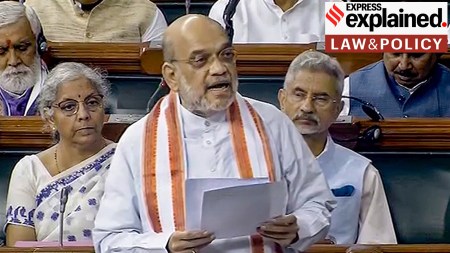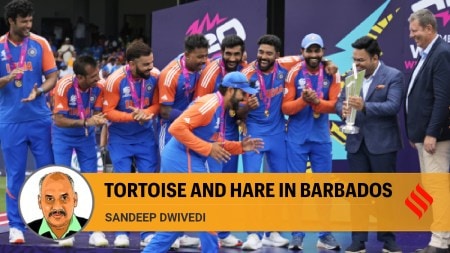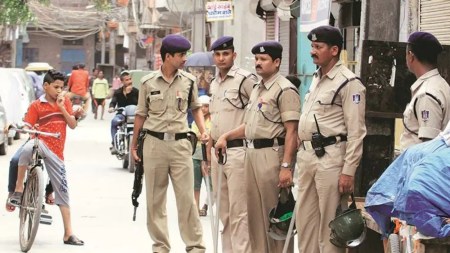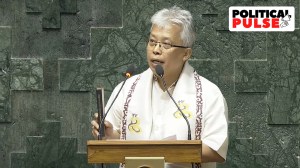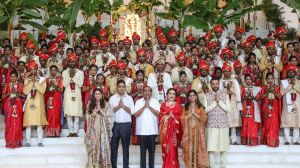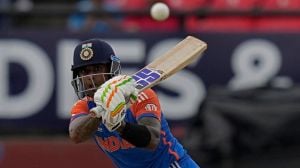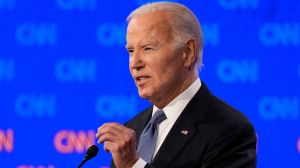- India
- International
UPSC Essentials | Daily subject-wise quiz : Economy MCQs on Digital rupee, ports in India and more (Week 63)
Are you preparing for UPSC CSE Prelims 2025? Check your progress and revise your topics through this quiz on Economy.
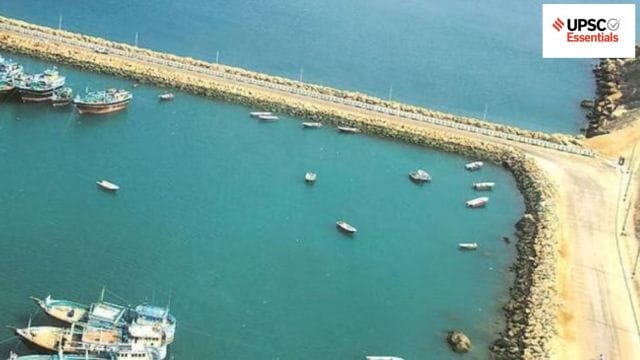 The initial ports in the effort are to be Paradip in the east, Kandla in the west, and Tuticorin in the south. Find a question on ports in India in today's quiz. (File image)
The initial ports in the effort are to be Paradip in the east, Kandla in the west, and Tuticorin in the south. Find a question on ports in India in today's quiz. (File image)UPSC Essentials brings to you its initiative of subject-wise quizzes. These quizzes are designed to help you revise some of the most important topics from the static part of the syllabus. Each day, we will cover one new subject. Attempt today’s subject quiz on Economy to check your progress. Come back tomorrow to solve the MCQs on International Relations. Don’t miss checking the answers and explanations at the end of the quiz.
🚨 The Indian Express UPSC Essentials brings to you the June edition of its monthly magazine. Click Here to read. Share your views and suggestions in the comment box or at manas.srivastava@indianexpress.com🚨
QUESTION 1
Consider the following statements in respect of the digital rupee:
1. It is a sovereign currency issued by the Reserve Bank of India in alignment with its monetary policy.
2. It appears as a liability on the RBI’s balance sheet.
3. It is insured against inflation by its very design.
4. It is freely convertible against commercial bank money and cash.
Which of the statements given above are correct? (UPSC 2024)
(a) 1 and 2 only
(b) 1 and 3 only
(c) 2 and 4 only
(d) 1, 2 and 4

QUESTION 2
With reference to the ports in India, consider the following statements:
1. The Jawaharlal Nehru Port Trust is India’s largest major port, whereas Mudra is the largest private port.
2. Kandla Port became the first 100% Landlord Major Port.
3. Chennai Port handled the maximum Cargo during 2022-23.
Which of the statements given above is/are correct?
(a) 1, 2 and 3
(b) 2 only
(c) 1 only
(d) 3 only
QUESTION 3
Consider the following statements:
1. RBI can cancel the licence of the co-operative bank if the bank fails to comply with the requirements of sections of the Banking Regulation Act, 1949.
2. On liquidation, every depositor would be entitled to receive a deposit insurance claim amount of his/her deposits up to a monetary ceiling of Rs One lakh from Deposit Insurance and Credit Guarantee Corporation (DICGC).
Which of the statements given above is/are correct?
(a) 1 only
(b) 2 only
(c) Both 1 and 2
(d) Neither 1 nor 2
QUESTION 4
With reference to the Pradhan Mantri Shram Yogi Maan-dhan (PM-SYM) Yojana, consider the following statements:
1. The entry age group for enrolment in the scheme is 21 to 40 years.
2. Age specific contribution shall be made by the beneficiary.
3. Each subscriber under the scheme shall receive a minimum pension of 3,000 per month after attaining the age of 60 years.
4. Family pension is applicable to the spouse and unmarried daughters.
Which of the statements given above is/are correct? (UPSC 2024)
(a) 1, 3 and 4
(b) 2 and 3 only
(c) 2 only
(d) 1, 2 and 4
QUESTION 5
With reference to the Digital India Land Records Modernisation Programme, consider the following statements:
1. To implement the scheme, the Central Government provides 100% funding.
2. Under the Scheme, Cadastral Maps are digitised.
3. An initiative has been undertaken to transliterate the Records of Rights from local language to any of the languages recognised by the Constitution of India.
Which of the statements given above are correct? (UPSC 2024)
(a) 1 and 2 only
(b) 2 and 3 only
(c) 1 and 3 only
(d) 1, 2 and 3
ANSWERS TO THE MCQs
1. (d)
FYI:
— The Central Bank Digital Currency (CBDC) — digital rupee or e-rupee (e₹) is a legal tender issued by the RBI in digital form. Hence, statement 1 is correct.
— It is identical to the fiat currency and can be exchanged 1:1. Only its form differs from that of actual cash, which is made of paper (or polymer). Hence, statement 4 is correct.
— It is a fungible legal money that does not need holders to have a bank account. CBDC will be recorded as a ‘liability’ (currency in circulation) on the RBI’s balance sheet. Hence, statement 2 is correct.
— E-rupees will be issued in the same denominations as paper currency and coins and distributed through intermediaries, i.e. banks. Transactions will be processed through a digital wallet provided by the participating banks and kept on mobile phones and gadgets. It is not insured against inflation. Hence, statement 3 is not correct.
— Transactions can be either person-to-person (P2P) or person-to-merchant. QR codes will be provided for P2M transactions (such as shopping), there will be QR codes at the merchant’s location.
— A user will be able to withdraw digital tokens from banks in the same way that she presently withdraws actual cash. She will be able to store her digital tokens in the wallet, spend them online or in person, or transfer them via an app.
— CBDC is intended for restricted access to specific financial institutions. It has the potential to transform the settlement systems for financial transactions conducted by banks in the government securities (G-Sec) segment and the interbank market, as well as make the capital market more efficient and secure in terms of operational costs, collateral use, and liquidity management.
— CBDC has the potential to bring major benefits, including reduced reliance on cash, increased seigniorage due to lower transaction costs, and reduced settlement risk.
Therefore, option (d) is the correct answer.
2. (c)
FYI:
— India has 12 major and 200 non-major/intermediate ports (under state government administration). The 12 major ports are — Deendayal (Kandla), Mumbai, Mormugao, New Mangalore, Cochin, Chennai, Ennore (Kamarajar), Tuticorin (V O Chidambaranar), Visakhapatnam, Paradip and Kolkata (including Haldia) and Jawaharlal Nehru Port.
— Jawaharlal Nehru Port Trust is the largest major port in India, while Mudra is the largest private port. Hence, statement 1 is correct.
— Jawaharlal Nehru Port became the first 100% Landlord Major Port. Hence, statement 2 is not correct.
— Amongst the Major Ports, Deendayal Port handled the maximum Cargo of 137.56 Mn Tonnes with a share of 17.6% followed by Paradip Port (17.3%), JNPA (10.7%), Visakhapatnam Port(9.4%), Mumbai Port(8.1%), Chennai Port(6.2%), SMP Haldia (6.2%), Kamarajar Port (5.6%), NMPA (5.3%), VOC Port (4.8%), Cochin Port (4.5%), Mormugao Port (2.2%) and SMP Kolkata (2.1%) during Apr-Mar, 2022-23. Hence, statement 3 is not correct.
Therefore, option (c) is the correct answer.
3. (a)
FYI:
— The Reserve Bank of India (RBI) has cancelled the licence of the City Co-operative Bank Ltd, Mumbai as “the bank does not have adequate capital and earning prospects”.
— The bank will no longer conduct banking activity after the close of business on June 19, 2024.
— The bank failed to meet the standards of Sections of the Banking Regulation Act, 1949. Hence, statement 1 is correct.
— The bank’s continued existence harms the depositors’ interests. If the bank is allowed to continue operating in its current financial state, it will be unable to pay its current depositors in full, and the public interest will suffer as a result.
— On liquidation, every depositor would be entitled to receive deposit insurance claim amount of his/her deposits up to a monetary ceiling of Rs five lakh from Deposit Insurance and Credit Guarantee Corporation (DICGC) subject to the provisions of DICGC Act, 1961. Hence, statement 2 is not correct.
Therefore, option (a) is the correct answer.
4. (b)
FYI:
— The Pradhan Mantri Shram Yogi Mandhan Yojana was launched in 2019 to provide a social security pension scheme for workers in the unorganised sector. The contribution made by beneficiary are age specific. Hence, statement 2 is correct.
— Under the scheme, an assured monthly pension of Rs 3,000 per month will be provided to workers in the unorganised sector after 60 years of age. Hence, statement 3 is correct.
Eligibility Criteria
(i) Should be an unorganised worker (UW)
(ii) Entry age between 18 and 40 years Hence, statement 1 is not correct.
(iii) Monthly Income Rs 15000 or below
— If the subscriber dies, the spouse of the beneficiary shall be entitled to receive 50% of the pension as family pension. Family pension is applicable only to spouse. Hence, statement 4 is not correct.
Therefore, option (b) is the correct answer.
(Other Source: http://www.epfindia.gov.in)
5. (d)
FYI:
— The National Land Records Modernization Programme (NLRMP), which was approved in 2008 as a Centrally Sponsored Scheme, has since been renamed the Digital India Land Records Modernization Programme (DILRMP) as a Central Sector Scheme with 100% Central funding, effective April 1, 2016. Hence, statement 1 is correct.
— DI-LRMP provides a common framework for reporting the progress of land record management by states/UTs.
— The programme has following major components:
(i) Computerization of land records;
(ii) Survey / resurvey and updating of the survey & settlement records (including ground control network and ground truthing);
(iii) Computerization of Registration;
(iv) Modern record rooms/land records management centres at tehsil/taluk/circle/block level;
(v) Training & capacity building;
(vi) Core GIS;
(vii) Legal changes;
(viii) Programme management.
— These components in effect translated into the following activities:
(i) computerisation of record of rights;
(ii) digitisation of cadastral maps; Hence, statement 2 is correct.
(iii) integration of record of rights (textual) and cadastral maps (spatial);
(iv) survey/re-survey;
(v) modern record rooms;
(vi) computer centres at tehsil, subdivision, district and data centre at state level;
(vii) connectivity between revenue offices;
(viii) computerization of registration; connectivity between sub-registrar offices and tehsils; and
(ix) integration of registration and land records.
— Currently, records of rights in states and union territories are kept in local languages. Linguistic obstacles make it difficult to access and use information in an understandable fashion. To address the issue of linguistic barriers in land governance, the government, with the technical assistance of the Centre for Development of Advanced Computing (C-DAC) Pune, has launched an initiative to transliterate Records of Rights available in local languages into any of the 22 Schedule VIII languages of the Constitution. Hence, statement 3 is correct.
Therefore, option (d) is the correct answer.
(Other Source: cdnbbsr.s3waas.gov.in)
Previous Daily Subject-Wise-Quiz
Daily subject-wise quiz — Polity and Governance (Week 63)
Daily Subject-wise quiz — History, Culture, and Social Issues (Week 63)
Daily subject-wise quiz — Environment, Geography, Science and Technology (Week 63)
Daily subject-wise quiz — Economy (Week 62)
Daily subject-wise quiz – International Relations (Week 62)
Subscribe to our UPSC newsletter and stay updated with the news cues from the past week.
Jul 02: Latest News
- 01
- 02
- 03
- 04
- 05



